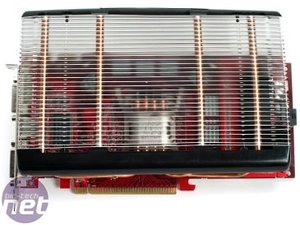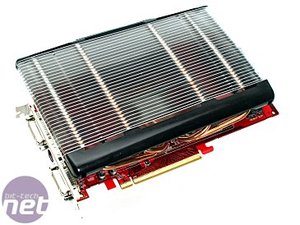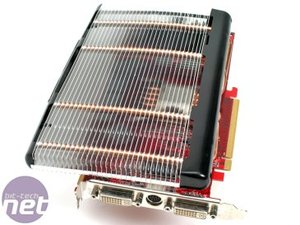
Despite the card being passively cooled, it still manages to keep in touch with the Radeon X1950 Pro’s reference specifications. ATI’s 80 nanometre RV570 chip is under the grill and set to Gas Mark 5, meaning all 36 pixel shaders, 12 texture units, 8 vertex shaders and 12 raster operators (ROPs) are fully functional. All of this simmers along at 575MHz, meaning the chip can spit out around 6,900 million sizzling fat droplets pixels every second at peak.
Of course, being a member of the X1000-series means that the chip is capable of an FP16 or Int10 blend – two file formats typically used for HDR lighting – whilst simultaneously applying a multi-sample anti-aliasing pattern to the scene. That is something which Nvidia was unable to do until it released its incredibly successful GeForce 8800-series graphics cards back in November 2006.
Also, the GPU supports ATI’s high quality anisotropic filtering algorithm too – another area where ATI has typically had an edge over Nvidia. However, Nvidia corrected the quite telling image quality differences with the GeForce 8-series architecture.
To round up the GPU’s other notable features, RV570 also supports ATI’s CrossFire technology natively via the internal CrossFire connectors (we’ll come back to this again shortly) and also uses ATI’s 512-bit internal Ring Bus memory controller. Although it’s a 512-bit internal memory interface, it’s still a 256-bit connection to the 256MB of local GDDR3 memory. While on the subject of memory, the 256MB of on-board memory is clocked at 685/1370MHz – that’s 5MHz lower than ATI’s reference frequency of 690MHz (1380MHz DDR).
In order to passively cool ATI’s RV570 graphics processor, PowerColor teamed up with the extremely talented chaps at Arctic Cooling and have used a design that’s similar to the Accelero S2. This isn’t the first time that the two have worked together though. If we jog our minds back to the end of October, we looked at another Radeon X1950 Pro which also benefited from the two companies working together, as it used Arctic Cooling’s Accelero X2 instead of the reference cooling solution.
Without a doubt, the main portion of the heatsink dominates the card’s design to such an extent that it gets in the way of some of the card’s features. Because of the sheer size of the array of aluminium fins, it’s not possible to run a pair of these in CrossFire using a pair of ATI’s internal bridge connectors. Something that’s probably more of an immediate concern is whether or not this card fits in an ATX chassis, given the size of the heatsink. Thankfully it does... just. If it didn’t, it’d definitely be a mistake fit for blunder of the year.
Getting back to the heatsink though... there are four copper heatpipes that come out from the plate that comes into contact with the GPU, out, round and through the array of aluminium fins to ensure maximum dissipation from all of the cooling surface available. Like the rest of the heatsink, the plate that touches the GPU core is also a hybrid material – the base is copper, whilst the bit that clamps the heatpipes onto the base is cast in aluminium.
That’s not all though, as there is more cooling on the card than the heatsink we’ve been taking the rip out of for the last couple of pages. The PWM circuitry on ATI’s reference PCB design gets pretty hot and requires additional cooling – the reference cooler actually covered these hot portions of the card and cooled them adequately with an all-in-one solution.
Because PowerColor has opted to move away from the reference cooler, despite keeping the same PCB design, the cooling engineers have had to design a small black heatsink to cover the PWMs. Thankfully, the heatsink fits right under the Accelero S2 and you’ll never really notice it’s there. To finish up on the cooling front, PowerColor has opted to cool the eight DRAM chips with individual BGA memory heatsinks made from aluminium.
Moving onto the selection of ports on the card’s PCI bracket, there’s a couple of HDCP compliant dual-link DVI ports capable of running a pair of monitors at resolutions up to 2560x1600 each. Additionally, there is also a VIVO port separating the two DVI connectors – the VIVO functionality comes courtesy of ATI’s Rage Theater chip, which is located on the top side of the PCB under the mass of aluminium.
Of course, being a member of the X1000-series means that the chip is capable of an FP16 or Int10 blend – two file formats typically used for HDR lighting – whilst simultaneously applying a multi-sample anti-aliasing pattern to the scene. That is something which Nvidia was unable to do until it released its incredibly successful GeForce 8800-series graphics cards back in November 2006.
Also, the GPU supports ATI’s high quality anisotropic filtering algorithm too – another area where ATI has typically had an edge over Nvidia. However, Nvidia corrected the quite telling image quality differences with the GeForce 8-series architecture.
To round up the GPU’s other notable features, RV570 also supports ATI’s CrossFire technology natively via the internal CrossFire connectors (we’ll come back to this again shortly) and also uses ATI’s 512-bit internal Ring Bus memory controller. Although it’s a 512-bit internal memory interface, it’s still a 256-bit connection to the 256MB of local GDDR3 memory. While on the subject of memory, the 256MB of on-board memory is clocked at 685/1370MHz – that’s 5MHz lower than ATI’s reference frequency of 690MHz (1380MHz DDR).
In order to passively cool ATI’s RV570 graphics processor, PowerColor teamed up with the extremely talented chaps at Arctic Cooling and have used a design that’s similar to the Accelero S2. This isn’t the first time that the two have worked together though. If we jog our minds back to the end of October, we looked at another Radeon X1950 Pro which also benefited from the two companies working together, as it used Arctic Cooling’s Accelero X2 instead of the reference cooling solution.
Without a doubt, the main portion of the heatsink dominates the card’s design to such an extent that it gets in the way of some of the card’s features. Because of the sheer size of the array of aluminium fins, it’s not possible to run a pair of these in CrossFire using a pair of ATI’s internal bridge connectors. Something that’s probably more of an immediate concern is whether or not this card fits in an ATX chassis, given the size of the heatsink. Thankfully it does... just. If it didn’t, it’d definitely be a mistake fit for blunder of the year.
Getting back to the heatsink though... there are four copper heatpipes that come out from the plate that comes into contact with the GPU, out, round and through the array of aluminium fins to ensure maximum dissipation from all of the cooling surface available. Like the rest of the heatsink, the plate that touches the GPU core is also a hybrid material – the base is copper, whilst the bit that clamps the heatpipes onto the base is cast in aluminium.
That’s not all though, as there is more cooling on the card than the heatsink we’ve been taking the rip out of for the last couple of pages. The PWM circuitry on ATI’s reference PCB design gets pretty hot and requires additional cooling – the reference cooler actually covered these hot portions of the card and cooled them adequately with an all-in-one solution.
Because PowerColor has opted to move away from the reference cooler, despite keeping the same PCB design, the cooling engineers have had to design a small black heatsink to cover the PWMs. Thankfully, the heatsink fits right under the Accelero S2 and you’ll never really notice it’s there. To finish up on the cooling front, PowerColor has opted to cool the eight DRAM chips with individual BGA memory heatsinks made from aluminium.
Moving onto the selection of ports on the card’s PCI bracket, there’s a couple of HDCP compliant dual-link DVI ports capable of running a pair of monitors at resolutions up to 2560x1600 each. Additionally, there is also a VIVO port separating the two DVI connectors – the VIVO functionality comes courtesy of ATI’s Rage Theater chip, which is located on the top side of the PCB under the mass of aluminium.
Warranty:
PowerColor offers a two-year warranty covering parts and labour. During the first year in the product’s life, your point of contact is the retailer where you purchased the product. If you’re having problems getting hold of the retailer, or the retailer goes out of business, you will be able to make direct contact with PowerColor. During the second year of the warranty, you should talk directly with PowerColor if you are having issues with the product. This is what most other board partners include with their products, since it’s the required minimum in the European Union – it is an adequate warranty term for a card like this, in our opinion.
MSI MPG Velox 100R Chassis Review
October 14 2021 | 15:04












Want to comment? Please log in.